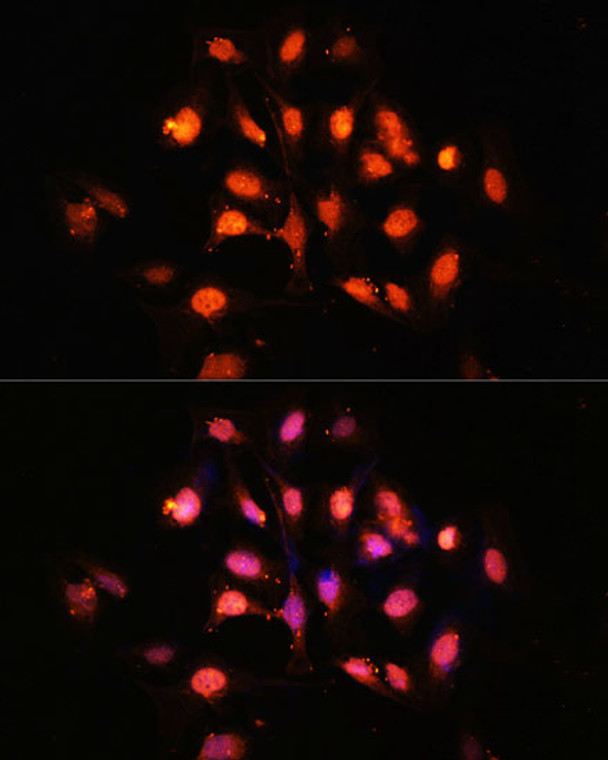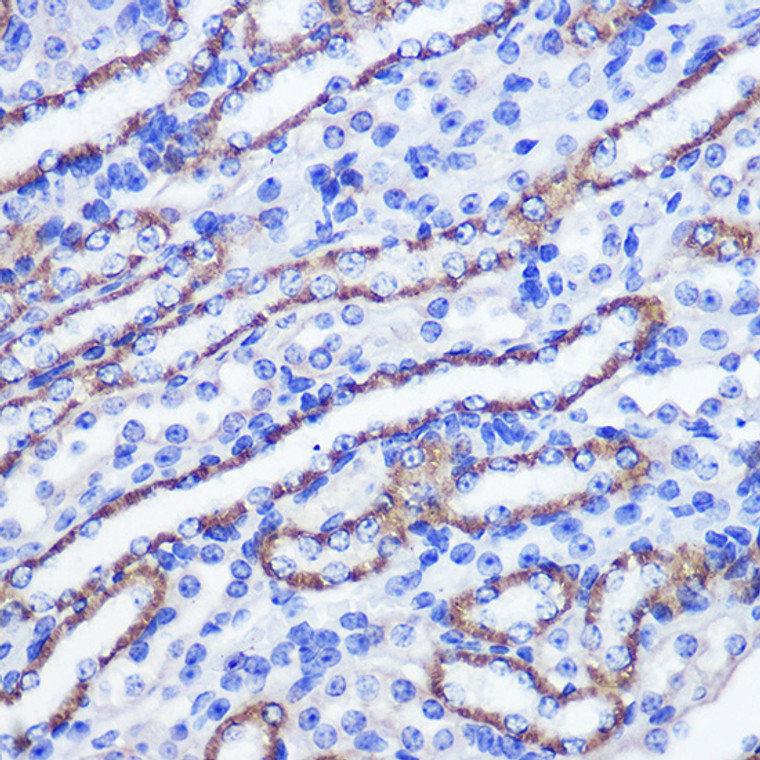| Host: |
Rabbit |
| Applications: |
WB/IHC/IF |
| Reactivity: |
Human/Mouse/Rat |
| Note: |
STRICTLY FOR FURTHER SCIENTIFIC RESEARCH USE ONLY (RUO). MUST NOT TO BE USED IN DIAGNOSTIC OR THERAPEUTIC APPLICATIONS. |
| Short Description: |
Rabbit polyclonal antibody anti-PHLPP1 (1160-1428) is suitable for use in Western Blot, Immunohistochemistry and Immunofluorescence research applications. |
| Clonality: |
Polyclonal |
| Conjugation: |
Unconjugated |
| Isotype: |
IgG |
| Formulation: |
PBS with 0.01% Thimerosal, 50% Glycerol, pH7.3. |
| Purification: |
Affinity purification |
| Dilution Range: |
WB 1:500-1:1000IHC-P 1:50-1:200IF/ICC 1:50-1:200 |
| Storage Instruction: |
Store at-20°C for up to 1 year from the date of receipt, and avoid repeat freeze-thaw cycles. |
| Gene Symbol: |
PHLPP1 |
| Gene ID: |
23239 |
| Uniprot ID: |
PHLP1_HUMAN |
| Immunogen Region: |
1160-1428 |
| Immunogen: |
Recombinant fusion protein containing a sequence corresponding to amino acids 1160-1428 of human PHLPP1 (NP_919431.2). |
| Immunogen Sequence: |
DQPSTGDASGAPAVWSHGYT EASGVKNKLCVAALSVNNFC DNREALYGVFDGDRNVEVPY LLQCTMSDILAEELQKTKNE EEYMVNTFIVMQRKLGTAGQ KLGGAAVLCHIKHDPVDPGG SFTLTSANVGKCQTVLCRNG KPLPLSRSYIMSCEEELKRI KQHKAIITEDGKVNGVTEST RILGYTFLHPSVVPRPHVQS VLLTPQDEFFILGSKGLWDS LSVEEAVEAVRNVPDALAA |
| Tissue Specificity | In colorectal cancer tissue, expression is highest in the surface epithelium of normal colonic mucosa adjacent to the cancer tissue but is largely excluded from the crypt bases. Expression is lost or significantly decreased in 78% of tested tumors (at protein level). Ubiquitously expressed in non-cancerous tissues. |
| Function | Protein phosphatase involved in regulation of Akt and PKC signaling. Mediates dephosphorylation in the C-terminal domain hydrophobic motif of members of the AGC Ser/Thr protein kinase family.specifically acts on 'Ser-473' of AKT2 and AKT3, 'Ser-660' of PRKCB and 'Ser-657' of PRKCA. Isoform 2 seems to have a major role in regulating Akt signaling in hippocampal neurons. Akt regulates the balance between cell survival and apoptosis through a cascade that primarily alters the function of transcription factors that regulate pro- and antiapoptotic genes. Dephosphorylation of 'Ser-473' of Akt triggers apoptosis and suppression of tumor growth. Dephosphorylation of PRKCA and PRKCB leads to their destabilization and degradation. Dephosphorylates STK4 on 'Thr-387' leading to STK4 activation and apoptosis. Dephosphorylates RPS6KB1 and is involved in regulation of cap-dependent translation. Inhibits cancer cell proliferation and may act as a tumor suppressor. Dephosphorylates RAF1 inhibiting its kinase activity. May act as a negative regulator of K-Ras signaling in membrane rafts. Involved in the hippocampus-dependent long-term memory formation. Involved in circadian control by regulating the consolidation of circadian periodicity after resetting. Involved in development and function of regulatory T-cells. |
| Protein Name | Ph Domain Leucine-Rich Repeat-Containing Protein Phosphatase 1Pleckstrin Homology Domain-Containing Family E Member 1Ph Domain-Containing Family E Member 1Suprachiasmatic Nucleus Circadian Oscillatory ProteinHscop |
| Database Links | Reactome: R-HSA-199418 |
| Cellular Localisation | CytoplasmMembranePeripheral Membrane ProteinNucleusIn Colorectal Cancer TissueExpression Is Concentrated At The Lateral Membrane Of Epithelial CellsIsoform 2: Cell Membrane |
| Alternative Antibody Names | Anti-Ph Domain Leucine-Rich Repeat-Containing Protein Phosphatase 1 antibodyAnti-Pleckstrin Homology Domain-Containing Family E Member 1 antibodyAnti-Ph Domain-Containing Family E Member 1 antibodyAnti-Suprachiasmatic Nucleus Circadian Oscillatory Protein antibodyAnti-Hscop antibodyAnti-PHLPP1 antibodyAnti-KIAA0606 antibodyAnti-PHLPP antibodyAnti-PLEKHE1 antibodyAnti-SCOP antibody |
Information sourced from Uniprot.org
12 months for antibodies. 6 months for ELISA Kits. Please see website T&Cs for further guidance











